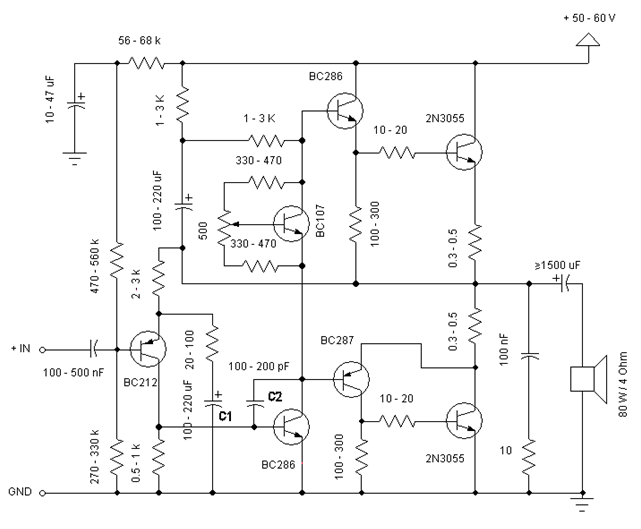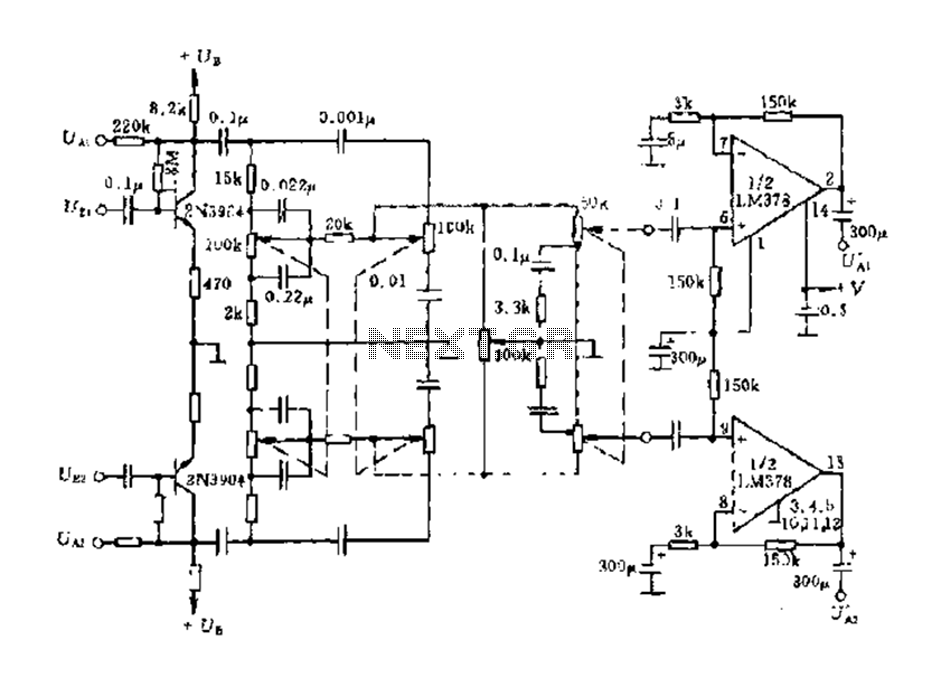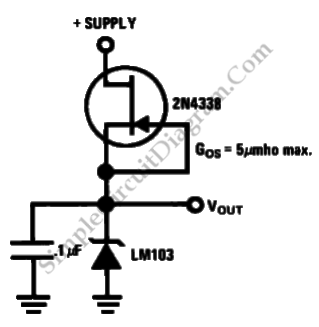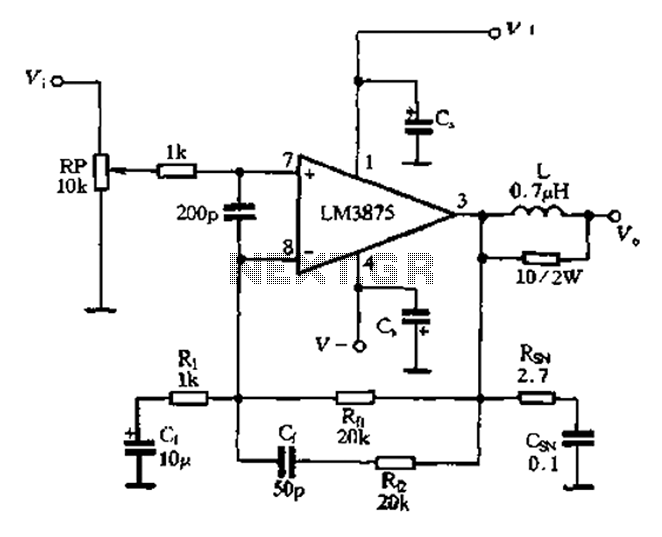
60 watt 2n3055 power amplifier

This architecture allows for a wide tolerance in component selection, enabling the use of various components that may be readily available. The transistors utilized can be any NPN type power transistor, excluding Darlington configurations. The output power is approximately 60W. This is a Class B amplifier, which means that a constant current flows through the output transistors, even when there is no signal at the input. This current can be adjusted using a 500-ohm trimmer resistor. As this current increases, the audio quality of the amplifier improves, although the output transistors experience more heat. Conversely, if the current decreases, the transistors generate less heat, but the audio quality deteriorates.
The described circuit is a Class B audio amplifier designed to provide an output power of approximately 60W. This configuration is characterized by its ability to handle a broad range of component tolerances, allowing for the use of commonly available NPN power transistors, while explicitly excluding Darlington pairs due to their different characteristics. The amplifier operates by utilizing two output transistors in a push-pull configuration, which enhances efficiency and reduces distortion in the audio signal.
The constant current flowing through the output stage is a critical parameter that can be adjusted with a 500-ohm trimmer resistor. This trimmer allows for fine-tuning of the idle current, which is essential for optimizing performance. Increasing the idle current improves audio fidelity by reducing crossover distortion, a common issue in Class B amplifiers. However, this comes with the trade-off of increased thermal output in the transistors, necessitating adequate heat sinking to prevent thermal runaway.
Conversely, lowering the idle current reduces heat generation in the transistors, which may extend their lifespan but can lead to degraded audio quality due to increased crossover distortion. The design must therefore strike a balance between thermal management and audio performance.
In terms of the circuit layout, careful attention should be paid to the placement of components to minimize parasitic capacitance and inductance, which can adversely affect performance. Adequate bypass capacitors should be placed near the power supply pins of the transistors to ensure stable operation and minimize noise. Additionally, the use of a robust power supply capable of delivering the necessary current without significant voltage drop is essential for maintaining performance under load conditions.
Overall, this Class B amplifier design is versatile and can be adapted for various applications, provided that the component selection and thermal management strategies are appropriately implemented.As you can see, in this architecture the apparatus accept a big tolerance, so you can body it about of the components, which you acquisition at home. The and transistors can be any NPN blazon ability transistor, but do not use Darlington types The achievement ability is about 60W.
- this is a chic B amplifier, this means, that a accepted charge breeze through the end transistors, alike if there is no arresting on the input. This accepted can be adapted with the 500 © trimmer resistor. As this accepted incrases, the complete of the amplifier gets better, but the end transistors are added heating. But if this accepted decrases, the transistors are not heating so much, but the complete gets worse 🔗 External reference
The described circuit is a Class B audio amplifier designed to provide an output power of approximately 60W. This configuration is characterized by its ability to handle a broad range of component tolerances, allowing for the use of commonly available NPN power transistors, while explicitly excluding Darlington pairs due to their different characteristics. The amplifier operates by utilizing two output transistors in a push-pull configuration, which enhances efficiency and reduces distortion in the audio signal.
The constant current flowing through the output stage is a critical parameter that can be adjusted with a 500-ohm trimmer resistor. This trimmer allows for fine-tuning of the idle current, which is essential for optimizing performance. Increasing the idle current improves audio fidelity by reducing crossover distortion, a common issue in Class B amplifiers. However, this comes with the trade-off of increased thermal output in the transistors, necessitating adequate heat sinking to prevent thermal runaway.
Conversely, lowering the idle current reduces heat generation in the transistors, which may extend their lifespan but can lead to degraded audio quality due to increased crossover distortion. The design must therefore strike a balance between thermal management and audio performance.
In terms of the circuit layout, careful attention should be paid to the placement of components to minimize parasitic capacitance and inductance, which can adversely affect performance. Adequate bypass capacitors should be placed near the power supply pins of the transistors to ensure stable operation and minimize noise. Additionally, the use of a robust power supply capable of delivering the necessary current without significant voltage drop is essential for maintaining performance under load conditions.
Overall, this Class B amplifier design is versatile and can be adapted for various applications, provided that the component selection and thermal management strategies are appropriately implemented.As you can see, in this architecture the apparatus accept a big tolerance, so you can body it about of the components, which you acquisition at home. The and transistors can be any NPN blazon ability transistor, but do not use Darlington types The achievement ability is about 60W.
- this is a chic B amplifier, this means, that a accepted charge breeze through the end transistors, alike if there is no arresting on the input. This accepted can be adapted with the 500 © trimmer resistor. As this accepted incrases, the complete of the amplifier gets better, but the end transistors are added heating. But if this accepted decrases, the transistors are not heating so much, but the complete gets worse 🔗 External reference





